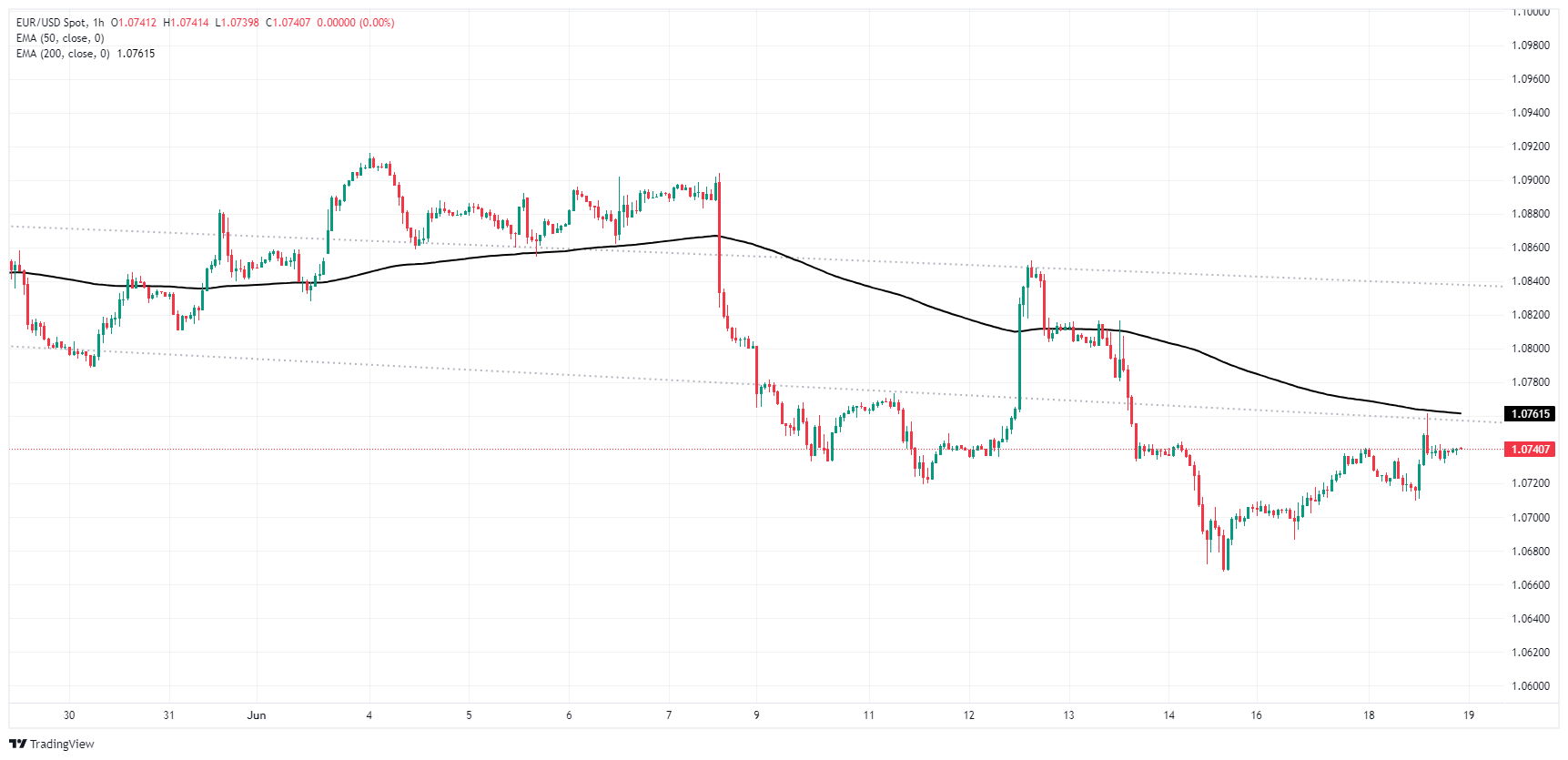EUR/USD softly higher, but technical pressures persist heading into lopsided Wednesday
- EUR/USD continues to recover from a near-term low around 1.0667.
- Euro sees mid-tier data docket until Friday’s PMI prints.
- US markets heading into a midweek holiday, market flows to be throttled.
EUR/USD is drifting slowly higher in tepid market conditions heading into a quiet Wednesday that sees low-impact EU data and darkened US markets for a midweek holiday shutdown. Broad-market sentiment continues to grind its way upwards as investors shrug off overly cautious talking points from a slew of Federal Reserve (Fed) officials.
Forex Today: Markets’ attention crosses the Channel
Federal Reserve officials lean into cautious stance as policymakers wait for further signs of easing
Wednesday’s economic calendar is muted regarding the Fiber, with US markets darkened for the Juneteenth midweek holiday and only mid-tier releases on offer for the Euro. the European Central Bank’s (ECB) latest Economic Bulletin will be released, and German Producer Price Index (PPI) figures are expected to recover. MoM German PPI is forecast to tick up to 0.3% from the previous 0.2%, and annualized German PPI is expected to rebound to -2.0% YoY from -3.3%.
EUR/USD traders will be hunkering down for the wait to Friday’s Purchasing Managers Index (PMI) print, where the trading week will wrap up with an update on economic activity expectations for June. The Pan-European HCOB manufacturing PMI is expected to climb to 47.9 MoM from 47.3, with the Services component forecast to tick up to 53.5 from 53.2. On the US side, both the Manufacturing and Services components are expected to decline. The Manufacturing component is forecasted to decrease to 51.0 from 51.3, and the Services PMI is expected to drop to 53.3 from 54.8.
EUR/USD technical outlook
EUR/USD is struggling under the weight of technical pressure from the 200-hour Exponential Moving Average (EMA) at 1.0767. Bids have struggled to recover above 1.0750 despite pushing up from near-term lows around 1.0670.
Daily candlesticks are poised for a bullish extension to the 200-day EMA near the 1.0800 handle, but descending technical resistance from late December’s peaks near 1.1140 are weighing on bullish momentum, and a downside reversal could drag the Fiber into fresh lows for 2024 below 1.0600.
EUR/USD hourly chart
EUR/USD daily chart
Euro FAQs
The Euro is the currency for the 20 European Union countries that belong to the Eurozone. It is the second most heavily traded currency in the world behind the US Dollar. In 2022, it accounted for 31% of all foreign exchange transactions, with an average daily turnover of over $2.2 trillion a day. EUR/USD is the most heavily traded currency pair in the world, accounting for an estimated 30% off all transactions, followed by EUR/JPY (4%), EUR/GBP (3%) and EUR/AUD (2%).
The European Central Bank (ECB) in Frankfurt, Germany, is the reserve bank for the Eurozone. The ECB sets interest rates and manages monetary policy. The ECB’s primary mandate is to maintain price stability, which means either controlling inflation or stimulating growth. Its primary tool is the raising or lowering of interest rates. Relatively high interest rates – or the expectation of higher rates – will usually benefit the Euro and vice versa. The ECB Governing Council makes monetary policy decisions at meetings held eight times a year. Decisions are made by heads of the Eurozone national banks and six permanent members, including the President of the ECB, Christine Lagarde.
Eurozone inflation data, measured by the Harmonized Index of Consumer Prices (HICP), is an important econometric for the Euro. If inflation rises more than expected, especially if above the ECB’s 2% target, it obliges the ECB to raise interest rates to bring it back under control. Relatively high interest rates compared to its counterparts will usually benefit the Euro, as it makes the region more attractive as a place for global investors to park their money.
Data releases gauge the health of the economy and can impact on the Euro. Indicators such as GDP, Manufacturing and Services PMIs, employment, and consumer sentiment surveys can all influence the direction of the single currency. A strong economy is good for the Euro. Not only does it attract more foreign investment but it may encourage the ECB to put up interest rates, which will directly strengthen the Euro. Otherwise, if economic data is weak, the Euro is likely to fall. Economic data for the four largest economies in the euro area (Germany, France, Italy and Spain) are especially significant, as they account for 75% of the Eurozone’s economy.
Another significant data release for the Euro is the Trade Balance. This indicator measures the difference between what a country earns from its exports and what it spends on imports over a given period. If a country produces highly sought after exports then its currency will gain in value purely from the extra demand created from foreign buyers seeking to purchase these goods. Therefore, a positive net Trade Balance strengthens a currency and vice versa for a negative balance.
